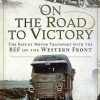On the Road to Victory: The Rise of Motor Transport with the BEF on the Western Front
£4.70
The Great War produced many innovations, in particular the spectacular development by the British and French armies of motor transport.
The age-old problem of moving soldiers and their supplies was no different in 1914 than it had been some 2,400 years ago, when the great Chinese military thinker Sun Tzu informed his readers that the further an army marched into enemy territory, the more the cost of transport increased, even to the point that more supplies were consumed by the transportation of men and their horses than was delivered to the troops.
Using many previously unpublished illustrations, including artists’ impressions, this book tells the story of the men and women who made motor transport work for the victorious British Army on the Western Front, so that in 1918, the humble lorry did indeed help propel the British Army forward on the road to victory.
Read more
Additional information
| Publisher | Pen & Sword Military (19 Feb. 2020) |
|---|---|
| Language | English |
| File size | 62847 KB |
| Text-to-Speech | Enabled |
| Screen Reader | Supported |
| Enhanced typesetting | Enabled |
| X-Ray | Not Enabled |
| Word Wise | Enabled |
| Sticky notes | On Kindle Scribe |
| Print length | 190 pages |










by CG
I looked forward to this as my grandfather served in a MT Company Army Service Corps from 1915 until demobbed in 1919. I have his service record so can follow his whereabouts. I had hoped this book would add to the details. In some ways it does.. the repair and maintenance of the roads for example. But perhaps too much focus on buses (it appears the author has a family connection to the bus industry) and too general. It jumps around to much (poor editing at Pen and Sword). For those who want a far more informative history of the ASC then Michael Young’s “Army Service Corps 1902 to 1918, also by Pen and Sword in 2000 remains the key text but is over £50 and seems no longer available on Kindle It is not even mentioned in the sources of this book which is strange.
by Tom Tank
The impact of the industrial revolution on warfare at the start of the Twentieth Century is well recorded. Books on the wholesale slaughter in the trenches of the Great War abound and the focus is on the machine gun and barbed wire. But World War 1 began shortly after the internal combustion engine appeared as a reliable means of powering motor vehicles.
In “On the Road to Victory – The rise of Motor Transport with the BEF on the Western Front,” Michael Harrison takes an intriguing look at the early days of “MT.” This is a record of how Motor Transport alongside the more traditional Horse Transport made a significant impact on logistics on the Western Front. But this is no dry text. It is a very human story and Michael Harrison’s book is a fitting tribute to the men and women of the Army Service Corps.
The story starts with civilian vehicles (and often their drivers) being pressed into service as the Great War started. As the War progressed and it became clear that MT was much more efficient than HT so the number of motor vehicles rapidly grew. Congestion quickly became a problem and many of the roads feeding the front had to adapt a one way system to keep the traffic flowing and the road surface serviceable.
The enormous engineering effort to keep the vehicles running and the roads usable is recorded in great detail but primarily this is a book about people. Those that built, policed and maintained the roads feature and much of the book is devoted to the heroic efforts of the drivers who, often under fire from the enemy, worked long and punishing hours to keep the supply chain intact.
The book is populated with numerous black and white photographs from the era, many being seen for the first time. There are several artist illustrations showing the principle vehicles.
This book will appeal to military historians interested in the First World War as this particular subject is not very well recorded elsewhere. Model makers will find many photographs that will inspire dioramas. Written in a non-academic style this book is an easy and fascinating read and is recommended to all that have an interest in this turbulent time.